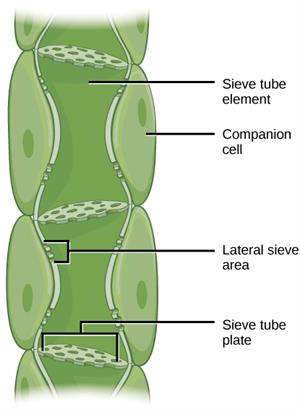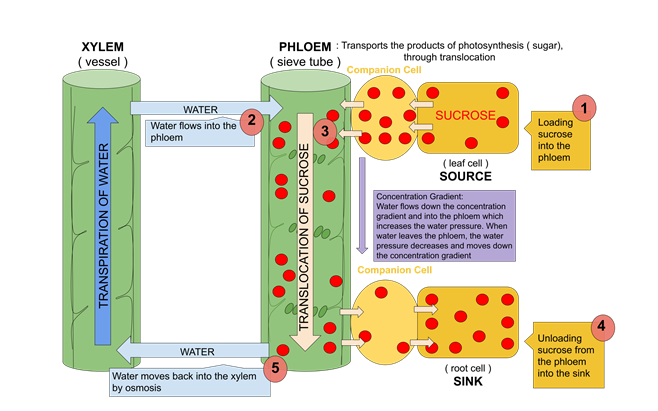
PUMPA - SMART LEARNING
எங்கள் ஆசிரியர்களுடன் 1-ஆன்-1 ஆலோசனை நேரத்தைப் பெறுங்கள். டாப்பர் ஆவதற்கு நாங்கள் பயிற்சி அளிப்போம்
Book Free DemoWe now know that how water and minerals are transported in plants. But what about the products of photosynthesis that are formed in the leaves? How are they transported to the other parts of the plants? Let us discuss it in detail.
Phloem transport:
As discussed earlier,
The soluble products of photosynthesis are transported to the other parts of the plant by the vascular tissue phloem and its components. This process of transportation is known as the translocation of solutes.
The phloem tissue of sieve tubes has sieve plates. These sieve plates have pores through which the cytoplasmic strands pass through.
The site where food is synthesised is known as a source (leaves), and the site where the food is stored is a sink (parts that need or store food).
The phloem tissue transports food (sucrose) from a source to a sink. These sources and sinks are not always constant. They may be reversed based on the seasons and needs of the plant.

Phloem
Directions of translocation:
As the relationship between the source and sink is a variable, the direction of movement in the phloem is also variable. It may be upwards or downwards, i.e., bidirectional. This is different from the movement observed in the xylem, i.e., upwards (unidirectional).
Downward translocation:
It is the transport of the products of photosynthesis from the leaves to the stems and roots for consumption and storage. It takes place in the sieve tubes with the help of adjacent companion cells.
It is the transport of the products of photosynthesis from the leaves to the stems and roots for consumption and storage. It takes place in the sieve tubes with the help of adjacent companion cells.
Upward translocation:
It occurs primarily during the germination of seeds, tubers, and other plants. When food is stored and transformed into a soluble form, it is transferred to the young seedling's upper growth section until it develops green leaves.
Translocation of sugars:
The pressure-flow hypothesis is the mechanism involved in the translocation of sugars from source to sink.

Translocation of sugars
- The glucose produced by the process of photosynthesis at the source is converted to sucrose.
- This sucrose moves into the companion cells, into the phloem sieve tube cells (living cells) by active transport resulting in a hypertonic condition in the phloem.
- Water present in the adjacent xylem moves into the phloem by osmosis.
- Due to this, osmotic pressure builds up. This pressure moves the phloem sap to the areas of lower pressure.
- Sucrose then moves to the sink, where it is used or stored by active transport.
- The osmotic pressure created decreases once the sugars are removed, and the water present in the phloem moves out.
A video explaining the process of translocation
Reference:
https://upload.wikimedia.org/wikipedia/commons/a/a7/Figure_30_05_06.jpg
https://upload.wikimedia.org/wikipedia/commons/thumb/f/fc/Translocation_from_the_source_to_the_sink_within_the_phloem.svg/2560px-Translocation_from_the_source_to_the_sink_within_the_phloem.svg.png